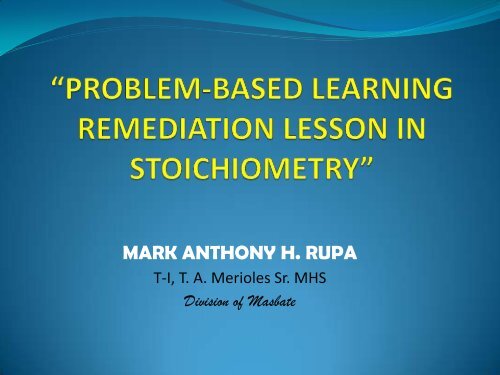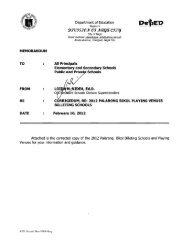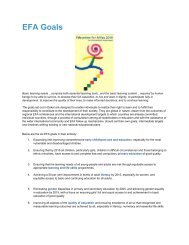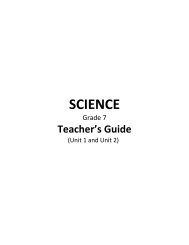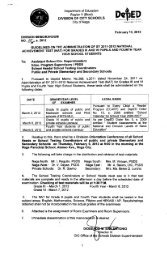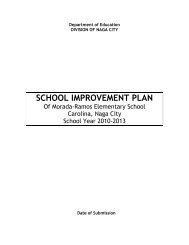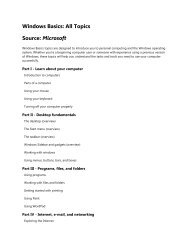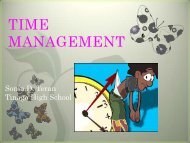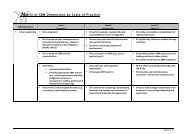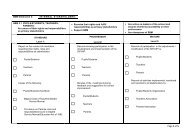problem-based learning remediation lesson in ... - DepEd Naga City
problem-based learning remediation lesson in ... - DepEd Naga City
problem-based learning remediation lesson in ... - DepEd Naga City
- No tags were found...
You also want an ePaper? Increase the reach of your titles
YUMPU automatically turns print PDFs into web optimized ePapers that Google loves.
MARK ANTHONY H. RUPAT-I, T. A. Merioles Sr. MHSDivision of Masbate
When students are <strong>learn<strong>in</strong>g</strong> poorly,we cannot expect them to be readyfor further <strong>learn<strong>in</strong>g</strong>, or for work.
Problems <strong>in</strong> Science Education•Poor scientific literacy and low successrates <strong>in</strong> Science Education;•Inappropriate teach<strong>in</strong>g methodologies;•Relevance and•Overloaded curriculum.
Difficulties <strong>in</strong> Learn<strong>in</strong>g Chemistry• Specialized vocabulary• Mathematical nature• The amount of material to be learned• Abstract conceptual nature
NAT MPS Secondary Education LevelPhilipp<strong>in</strong>es60402002003-2004 2004-2005 2005-2006 2006-2007 2007-2008Philipp<strong>in</strong>es 37.75 46.8 44.33 46.64 49.26
NAT Result SY 2007-2008• Solv<strong>in</strong>g the number of molesgiven the mass of a compound• Mole concept to determ<strong>in</strong>e thepercent composition of acompound• Chemical equations <strong>in</strong>volved <strong>in</strong>chemical processes.“ReactionStoichiometry”
Statement of the Problem• What <strong>remediation</strong> <strong>lesson</strong> may be developed us<strong>in</strong>gProblem-Based Learn<strong>in</strong>g approach?• What is the content validity of the <strong>lesson</strong> asdeterm<strong>in</strong>ed by experts <strong>in</strong> terms of objectives,<strong>learn<strong>in</strong>g</strong> experiences and assessment of outcomes <strong>in</strong>l<strong>in</strong>e with Problem-Based Learn<strong>in</strong>g?• What are the valued-added effects of PBL onconceptual understand<strong>in</strong>g, science process skills andattitude towards <strong>learn<strong>in</strong>g</strong> stoichiometry?
Theoretical FrameworkLearner’sExist<strong>in</strong>gKnowledgeProblem-BasedLearn<strong>in</strong>g(External Stimuli)ScientificInquiryAssimilationAccommodationDescriptiveInquiryCreation andTest<strong>in</strong>gLearner’sNewKnowledge
Conceptual FrameworkStoichiometryLessonUse ofPBLEvaluation of Experts as to: Consistency among objectives; Learn<strong>in</strong>g experiences, and Assessment of outcomes.ENHANCED:‣ ConceptualUnderstand<strong>in</strong>g‣ ScienceProcess Skills‣ PositiveAttitudetowardsStoichiometry
Research Design and Methodology• Pre-experimental research design specificallythe one-group-pretest-posttest design.• The respondents of this study were 55 thirdyear students of Temistocles A. Merioles Sr.Memorial High School, school year 2010-2011.
Instrumentation• Chemistry ConceptualUnderstand<strong>in</strong>g Test(CCUT)• Science Process SkillsTest (SPST)• Stoichiometry AttitudeScale• Expert’s Assessment ofthe PBL <strong>lesson</strong>• PBL Assessment Sheets• Evaluation Rubrics• Students’ Journal Entries
Results and Discussions
Identification of the least learnedtopics <strong>in</strong> the <strong>lesson</strong>• NAT result SY 2007-2008 on the national levelreached only “low mastery level”.• The researcher developed a <strong>lesson</strong> under the unit“Reaction Stoichiometry.”• N<strong>in</strong>e topics were <strong>in</strong>cluded <strong>in</strong> the unit to cover theother competencies such as: atomic mass, molarmass, and molecular mass; chemical reactions andequations; and percent composition, amounts ofproducts and reactants, and limit<strong>in</strong>g reagents andreaction yield.
Selection of the <strong>problem</strong> suited tothe students’ level of understand<strong>in</strong>g• Result of the testconducted to the student’safter the traditionalmethod of teach<strong>in</strong>g• Familiarity of the studentswith the process ofcarbonation• The <strong>problem</strong> was chosenfrom among the <strong>problem</strong>swhich are the most fitt<strong>in</strong>gto the real world• Open-ended• Arouse sense of curiosity• Focus on only one issue• Teach ethical and goodbehavior• Help students to reflectand express themselvesfreely.
“Investigation of the components of CARBONATED DRINKS”You are assigned as the new chief chemist <strong>in</strong> a company thatformulates f<strong>in</strong>est carbonated beverages <strong>in</strong> the country. Yourfirst assignment is to <strong>in</strong>vestigate a claim that has been filedregard<strong>in</strong>g five hundred thousand 8oz bottles of a productformulated <strong>in</strong> your laboratory. The report says that thebeverages taste flat. It is now your responsibility to determ<strong>in</strong>ewhat happened <strong>in</strong> the production of this product and to developa plan of action to correct the <strong>problem</strong>. You are to make areport to the production head immediately.
Eight Features of PBLexplore the <strong>problem</strong>,create hypotheses,identify issues andelaborate on the<strong>problem</strong>attempt to solve the<strong>problem</strong> <strong>based</strong> onprior knowledgeidentify what needs toknow and how that lackof <strong>in</strong>formation andknowledge is impend<strong>in</strong>ga solution to the <strong>problem</strong>prioritize <strong>learn<strong>in</strong>g</strong>needs, set own goalsand objectives, andallocate the use ofavailable resourcesdo the necessaryresearch, study, andpreparation to solvethe <strong>problem</strong>work <strong>in</strong> small groups andshare all new <strong>in</strong>formationand knowledgeeffectively so that allmembers have a commonbase of new <strong>learn<strong>in</strong>g</strong>apply the newknowledge to solvethe <strong>problem</strong>give feedback byassess<strong>in</strong>g the newknowledge, the <strong>problem</strong>solution, and theeffectiveness of theprocess used
LESSON FORMAT (2010 SEC)
Experts’ Assessment of the Content Validityof the Developed Remediation Lesson
Value-added Effects of PBL <strong>in</strong> termsof Conceptual Understand<strong>in</strong>g <strong>in</strong>Chemistry
Factors affect<strong>in</strong>g the development ofconceptual understand<strong>in</strong>g us<strong>in</strong>g PBL• Nature of the PBLprocess• Employ of the tutorguidancerole by thefacilitator• Motivation to learn• Long term retention ofthe content• Role of the students <strong>in</strong>the PBL sett<strong>in</strong>g
Value-added Effects of PBL <strong>in</strong> termsof Science Process Skills
Value-added Effects of PBL <strong>in</strong> termsof Attitude“Mas damo akon naarman sa stoich san gu<strong>in</strong>discuss <strong>in</strong>i paagi san PBL. Waran damo nacalculation, board work kag <strong>problem</strong> solv<strong>in</strong>g!”(I like the topic stoichiometry, when it is be<strong>in</strong>gpresented us<strong>in</strong>g PBL. Less calculations, boardwork and <strong>problem</strong> solv<strong>in</strong>g!)
Conclusions• A <strong>remediation</strong> <strong>lesson</strong> <strong>in</strong> stoichiometry cover<strong>in</strong>gthe topics: atomic mass, molar mass, andmolecular mass; chemical reactions andequations; and percent composition, amounts ofproducts and reactants, and limit<strong>in</strong>g reagents andreaction yield was developed us<strong>in</strong>g ProblemBased Learn<strong>in</strong>g approach.
Conclusions• The PBL <strong>lesson</strong> was rated by experts to be “excellent”<strong>in</strong> all these aspects: objectives; <strong>learn<strong>in</strong>g</strong> experiencesand assessment of outcomes.
Conclusions• The PBL <strong>lesson</strong> improved the students’ conceptualunderstand<strong>in</strong>g, science process skills and attitudetowards stoichiometry as evidenced by a largemean ga<strong>in</strong> <strong>in</strong> the tests on conceptualunderstand<strong>in</strong>g and science process skills and theshift from a less favorable attitude to a remarkablyfavorable attitude after the PBL <strong>lesson</strong>.
This study on the use of PBL can be a solution tomeet the current <strong>learn<strong>in</strong>g</strong> needs <strong>in</strong> scienceeducation. Therefore the educational system <strong>in</strong> thecountry should consider optimiz<strong>in</strong>g the use of PBL<strong>in</strong> the classroom. The use of PBL as an alternativeteach<strong>in</strong>g strategy cannot be accomplished all of asudden. It should be implemented cautiously as astrategic approach. Necessary preparationalmeasures should be taken to ensure implement<strong>in</strong>gthe approach towards more effective result.
Thank you!“Together we couldmake beautifulmolecules.”


